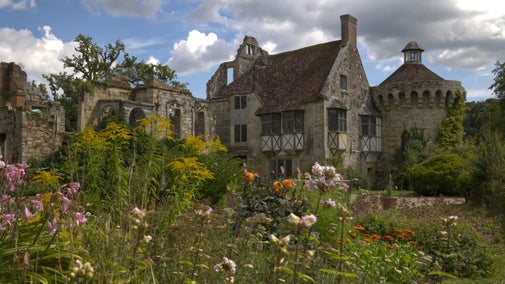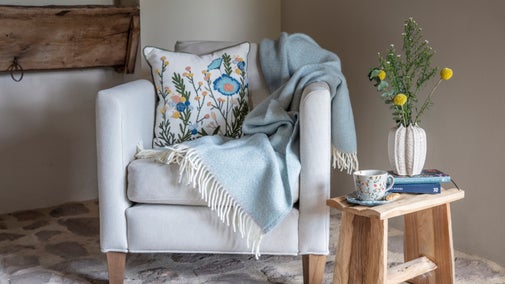
Discover more at Scotney Castle
Find out when Scotney Castle is open, how to get here, the things to see and do and more.

Nestled in the Bewl Valley on the boundary between Kent and Sussex, Scotney Castle has a well-deserved reputation for romance and picturesque loveliness, but its history shows a chequered past.
Originally with a circular tower at each of its four corners, the castle was built around 1378 by Roger de Ashburnham in response to the threat of French invasion. If you look carefully, you can see still see the foundation stones for the original castle at each corner of the castle island. The estate remained in the Ashburnham family until it was sold in 1418 to the Darell family.
The Darells lived here for the next 350 years, adding in the Tudor wing. Loyal Catholics, following the Reformation they had to practise their faith behind closed doors to prevent persecution. In 1591, when the authorities came knocking, the family used the castle’s secret priest hole to quickly hide Father Richard Blount. Later, under cover of darkness, he was then able to flee through the moat to safety.
Although the moat is not particularly deep, human waste from the castle's garde-robe (WC to us today) emptied into the moat so this would have been a rather unpleasant escape route - but undoubtedly still better than the alternative of being caught.
Much of the original medieval castle was demolished in the 17th century and a grand three-storey east range was built. Today only the walls of this section remain.
Around 1720 George Darell made further alterations, capping the Ashburnham Tower with its now characteristic conical tiled roof and glazed cupola. This Ashburnham tower is all that now remains of the original medieval castle.
Family squabbles, lawsuits and debt led to another change of ownership in the 1778 when Edward Hussey I bought the castle from the Darells. Between 1783 and 1792, Hussey pieced the rest of the old Darell estate back together.
Hussey's death in 1816 and, a year later, that of his son, Edward Hussey II, meant the old castle lay vacant for some years. The young Edward Hussey III was largely brought up by his widowed mother away from Scotney in St Leonards but, fascinated by architecture and landscape gardening when he came of age and inherited, he decided to move back to Scotney in 1835 and build a new house here.
Despite commonly-held beliefs, the old castle at Scotney is not a folly. Nor was it left to fall into disrepair nor destroyed by a fire. It was deliberately ruined in the mid-19th century to make the centrepiece of the garden being created around Edward Hussey III’s new house at the top of the hill.
Working with architect, Anthony Salvin, and with the advice of artist and landscape gardener, William Sawrey Gilpin, the new house was built in such a way that each window acts as a picture frame for the artfully-created views. Most notable is the view from the bay window in the Library down towards the Old Castle.
During the process of building the new house at Scotney, sandstone was quarried from the garden and several items, such as the hearth tiles now in the Hall and the fireplace surround in the Bamboo Bedroom, were salvaged from the then uninhabited Old Castle.
From a military perspective, its low-lying marshy location seems a strange place to build a castle and, as a family home, the damp environment undoubtedly created health issues but, surrounded by its moat and old roses and wisteria climbing its aged walls, its romantic credentials can’t be argued with. With acres of parkland on one side and cascading rhododendron-filled gardens on the other, its setting today is just perfect.
Estate staff lived in the old castle until 1905 but today its only inhabitants are a colony of bats on the top floor. The castle's interior is particularly fragile and cannot cope with large numbers of visitors all year round. For this reason, the building is only open to the public between April and October. when visitors can visit the ground and first floors of the building. The rooms are used as exhibition spaces but you can still look through one of the first floor windows on the first floor to enjoy the view.
Following an archaeological dig in the castle's inner courtyard in the summer of 2023, the garden team will plant a new and experimental sub-tropical garden, taking advantage of the courtyard's sheltered microclimate.
The Ashburnham Tower is not open to the public but the following images show what the upper floors of the tower currently look like - a narrow twisting staircase disappearing into nothing, the view down, and the beams of the circular cupola above.

Find out when Scotney Castle is open, how to get here, the things to see and do and more.
Discover the Picturesque garden and wider estate at Scotney Castle. Take time to look around as you explore and discover endless vistas and interesting angles for photographs and reflection.

There's nothing better than a warm spring day: fresh air, sunshine and food enjoyed in the outdoors. Whether you're going for the full lunch option or just a snack to keep you going 'til tea, there's a full range of savouries and bakes to entice you. And if the English weather doesn't play ball there'll always be jacket potatoes and fish finger sandwiches ...

Discover the long and rich history of Scotney Castle and its journey with the Hussey family from moated castle to idyllic country estate.

Discover some of what happens behind the scenes to care for the house and garden at Scotney Castle in Kent.

Join the volunteer team at Scotney Castle and help to make a real difference to this special place whilst learning new skills and making friends.

Discover our glorious spring/summer range in our main Courtyard shop. Pick up a perfect new accessory for yourself or your home - from gorgeous garden goods and wonderful printed scarves to embroidered cushions and beautiful ceramics. And do pop into the second-hand bookshop by the Visitor Entrance before you leave to discover some bargain recycled reads.

Discover our glorious spring/summer range in our main Courtyard shop. Pick up a perfect new accessory for yourself or your home - from gorgeous garden goods and wonderful printed scarves to embroidered cushions and beautiful ceramics. And do pop into the second-hand bookshop by the Visitor Entrance before you leave to discover some bargain recycled reads.
